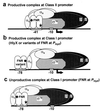Altering the anaerobic transcription factor FNR confers a hemolytic phenotype on Escherichia coli K12
- PMID: 9724723
- PMCID: PMC27914
- DOI: 10.1073/pnas.95.18.10449
Altering the anaerobic transcription factor FNR confers a hemolytic phenotype on Escherichia coli K12
Abstract
The recent outbreaks of Escherichia coli O157-associated food poisoning have focused attention on the virulence determinants of E. coli. Here, it is reported that single base substitutions in the fnr gene encoding the oxygen-responsive transcription regulator FNR (fumarate and nitrate reduction regulator) are sufficient to confer a hemolytic phenotype on E. coli K12, the widely used laboratory strain. The mechanism involves enhancing the expression of a normally dormant hemolysin gene (hlyE) located in the E. coli chromosome. The mutations direct single amino acid substitutions in the activating regions (AR1 and AR3) of FNR that contact RNA polymerase. It is concluded that altering a resident transcription regulator, or acquisition of a competent heterologous regulator, could generate a pool of hemolytic, and therefore more virulent, strains of E. coli in nature.
Figures


References
-
- Guest J R, Green J, Irvine A S, Spiro S. In: Regulation of Gene Expression in Escherichia coli. Lin E C C, Lynch A S, editors. Austin, TX: Landes; 1996. pp. 317–342.
-
- Lazazzera B A, Beinert H, Khoroshilova N, Kennedy M C, Kiley P J. J Biol Chem. 1996;271:2762–2768. - PubMed
-
- Jordan P, Thomson A J, Ralph E T, Guest J R, Green J. FEBS Lett. 1997;416:349–352. - PubMed
Publication types
MeSH terms
Substances
LinkOut - more resources
Full Text Sources
Other Literature Sources
Molecular Biology Databases

